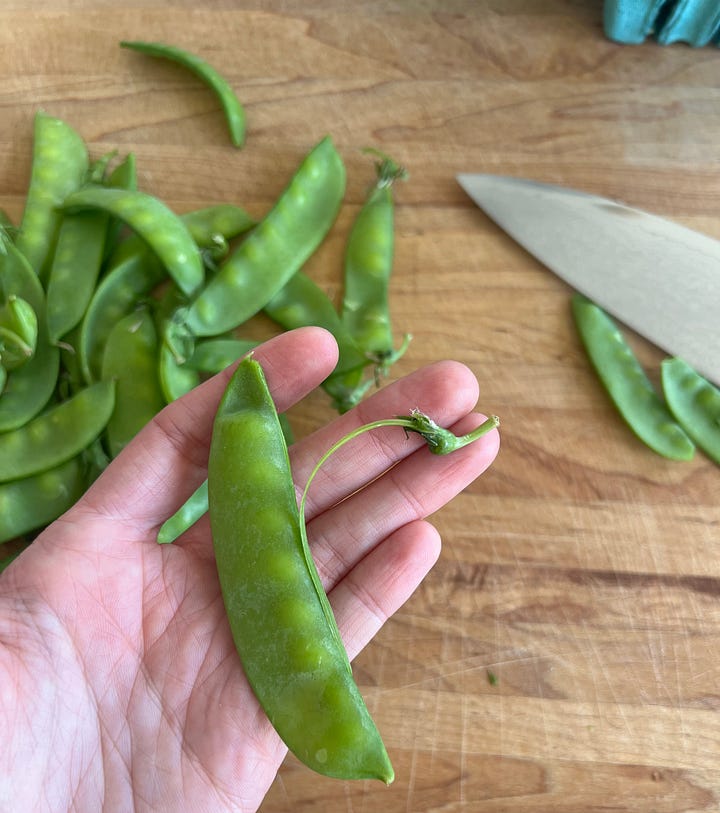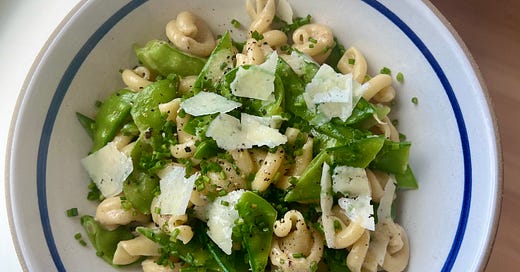If this just showed up in your inbox, that means you subscribed to my newsletter, and I love you! I’m so grateful that you’re here and that you want to support my work. If you like what you see, maybe you’ll think about forwarding this to a friend? If you’re reading this and you’re wondering who the hell I am and what the hell buona forchetta means, here’s a little intro, and I hope you’ll consider subscribing below. And if you pledged money to support this newsletter, thank you!!! I want buona forchetta to be free for the foreseeable future, but your support means the world to me.
Starting a newsletter is an idea I’ve toyed with for years, but I’m usually stopped in my tracks by a fun cocktail of anxiety, imposter syndrome, and procrastination. The food writing world is crowded and loud, and sometimes it feels like everyone and their mother has a newsletter or a blog, or a viral food video account turned cookbook, or access to the internet and therefore a recipe for every dish ever. If twenty other food writers have already told you about the importance of reserving your pasta water, what do I have to add? What does anyone really have to add? What does it all mean? Cue existential spiral.
Clearly, big picture thinking can be dangerous, so instead I’ve decided to think small. What if you want to see what I’m making for dinner? Let’s start there.
Anyone who knows me would probably be shocked if my first newsletter did not feature a pasta recipe. Pasta means everything to me; it is one of my very favorite things to eat, cook, and talk about.
So, here’s a very simple pasta for (very) late spring. It’s rich and satisfying, but bright and vegetal, with bite and sweetness from just-blanched snow peas, nuttiness from browned butter, and salty sharpness from pecorino romano. I chose snow peas here because they are a vegetable I really only want to eat in June, when they are plump, crisp, and sweet—not to mention incredibly cute. If you haven’t worked with snow peas before, to trim them, you’ll want to snap off their adorable little hats and pull out the sturdy string that runs down their inside. I personally find this to be one of the most satisfying kitchen prep tasks.


You can totally swap these snow peas for thinly sliced sugar snap peas, or fresh shelled peas, or green beans cut into bite sized pieces, or just throw in half a bag of frozen peas right at the end of cooking if you can’t be bothered to buy or prep something fresh. In spite of the fact that I’m writing recipes here, I believe in developing techniques and learning to taste and adjust to your liking so that you can become a more confident cook. I’ll always provide suggestions for ways to riff and play, and swaps so that you can use up what’s in your fridge and pantry. I like pecorino here for its sharp saltiness to offset the natural sweetness of the peas, but you can absolutely use parm if that’s what you have.
Browning butter, or cooking it until the fat melts, the water cooks off, and the milk solids toast and turn deeply golden brown and toasty, is often a good idea. It turns simple buttery richness into something way more complex and it makes your house smell great. Here, I add smashed garlic cloves in with the butter so that they become soft and golden and infuse the butter with mild garlicky flavor as it browns. I give the sauce a peppery bite by blooming lots of freshly ground black pepper in the butter—I won’t provide a measurement, (because who really grinds and measures freshly cracked pepper?) but keep on twisting that grinder until it feels annoying. If you’ve ever had cacio e pepe, you know that tons of black pepper and pecorino play very well together.
This is one of my favorite kinds of recipes: a short list of ingredients, treated thoughtfully, that come together to yield something more than the sum of their parts. This dish actually comes together so quickly that you can make it in the time it takes to boil water and cook pasta. You can prep your ingredients while the water comes up to a boil, brown the butter while the pasta cooks, and blanch the snow peas right along with the pasta. Then, you simmer the pasta and peas in the peppery brown butter, so they soak up all that flavor as they finish cooking. And the real magic happens when the starchy, salty pasta water and brown butter cling to the noodles with the addition of the finely grated cheese. I add lemon zest at the end for brightness, and I like to finish each bowl with a showering of fresh chives for a springy, oniony bite, plus a few more shavings of pecorino. Without further ado, here she is:
Pasta with Snow Peas & Pecorino
Serves 4
Ingredients:
Kosher salt
1 pound short pasta, such as mezzi rigatoni, orecchiette, or whatever feels fun to you (the Vesuvio shape from Sfoglini felt fun to me)
6 tablespoons butter, cut into a few pieces
5 garlic cloves, smashed and peeled
Freshly ground black pepper
12 ounces snow peas, trimmed and halved crosswise or cut into thirds if large
Zest of one lemon
4 ounces freshly grated pecorino romano, plus more for serving
1 bunch chives, thinly sliced
Bring a large pot of water to a boil. Season the water generously with salt (more than you think!) and add the pasta. Stir and set a timer for 2 minutes fewer than the package instructions indicate for al dente.
Add the butter and garlic to a large skillet or Dutch oven and set over medium heat. Cook, stirring occasionally, until the butter melts and just begins to foam and sputter a bit, 2 to 3 minutes. Add lots of freshly ground black pepper. Continue to cook, stirring and scraping the bottom of the pan frequently, until the butter becomes very foamy, smells toasty and nutty, and is flecked with many deeply golden brown milk solids, another 3 to 4 minutes. Using a ladle or a measuring cup, add a splash of pasta water to the skillet. (It will bubble up and make a scary noise for a second, but things will quiet down quickly. This is a nice way to stop the garlic and butter from browning any further.) Turn the heat down to a bare simmer until your pasta is ready.
When the timer goes off, add the snow peas to the pasta water and cook for about one minute, just until they turn bright green.
Reserve 1/2 cup or so of pasta water and then drain the pasta and peas and immediately transfer them to the skillet. Raise the heat to medium high and add a big splash of the reserved pasta water. Cook, stirring frequently and adding another splash or two of water as needed, until the pasta is al dente and the pasta water begins to thicken, about 2 minutes. Turn off the heat and add the lemon zest. Then begin adding the grated pecorino in batches while stirring constantly, until the cheese melts and the sauce looks glossy and really clings to the noodles. If the sauce begins to tighten or the cheese clumps up, add another splash of the pasta water to loosen things up. Taste and add more salt if it needs it.
Serve the pasta in shallow bowls and top with a generous showering of the chopped chives, some more pepper, and more pecorino romano, grated or shaved with a vegetable peeler.
Buon appetito!
More soon,
Megan




